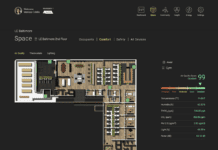
By Gene Smithart, P.E., LEED AP
From the August 2013 issue of Today’s Facility Manager
Striving to achieve ever higher levels of building performance, designers of many of the most energy efficient high performance, commercial buildings are using spiral round ductwork, and with good reason. Static regain designed spiral round ducting costs about one-fourth less, weighs 25% less, is quicker and easier to install, and takes up less space than conventional rectangular ducting in variable air volume (VAV) or constant volume systems, according to the Spiral Duct Association (SPIDA). Doing more with less (less cost, less energy, and less material) is a hallmark of the high performance building concept.
Static regain is a method in which ducts are sized so that the regain in static pressure due to decreased velocity between two points totally or partially compensates for the frictional resistance between the points. This helps create more uniform static pressure at the various branches and outlets aiding in self balancing of the system and reduced sound levels due to duct over-pressurization.
An aspect of particular interest to facility managers (fms) is that spiral round ducting also enables better HVAC system performance than does rectangular ductwork. Systems that include static regain designed spiral round ductwork use less energy, deliver air to every VAV box, and create a more comfortable indoor environment for occupants and visitors.
For example, duct leakage of as much as 10% was common in buildings with rectangular ductwork just 10 years ago. With newer sealing technologies, leakage in rectangular ductwork can be reduced to about 3%. However, round ductwork can provide leakage rates of less than 1%, according to SPIDA.
Reducing leakage can have a profound impact on both HVAC energy efficiency and occupant comfort by ensuring that the right amount of conditioned air is directed to the intended locations within a facility. The result is fewer comfort calls for the facility staff and higher levels of indoor air quality.
Tighter ductwork also means better energy efficiency. In fact, with a modern, high efficiency HVAC system in place, reducing leakage from 10% to 1% has the equivalent effect of a 29% boost in fan energy. Even a reduction from 3% to 1% in leakage can deliver a 6% savings in fan energy according to calculations by Trane, a provider of indoor comfort solutions and services.
With spiral round ductwork, system designers can use significantly higher air velocity than they can with conventional rectangular duct systems, according to the American Society of Heating, Refrigerating and Air-Conditioning Engineers (ASHRAE). This can be done with equal or lower acoustic performance compared to rectangular ductwork. Higher velocity, static regain designs are state-of-the-art for current lower installed cost VAV systems.
Another positive aspect is that round ductwork can be designed using higher velocities without higher external fan static pressures. The fitting losses of round ductwork are lower than those of rectangular ductwork. Since fitting losses represent a significant percentage of ductwork friction losses, a high velocity, static regain round duct system can be designed at equal, or even lower, fan static pressure than with traditional rectangular ductwork.
This efficiency advantage can be further enhanced by use of direct digital control (DDC) strategies. For example with DDC/VAV controls, fan pressure optimization can be achieved by identifying which VAV box in the system requires the maximum static pressure and then controlling the fan to provide just that amount of static pressure and no more. This strategy has the potential to save 20% to 40% compared to a non-optimized system, Trane has found. The good news for operators is there are cost-effective ways to upgrade older, pneumatically controlled VAV boxes to also use this technology. Meanwhile, various building automation systems can provide advanced control strategies like fan pressure optimization.

Spiral round ductwork is a suitable alternative to rectangular ductwork in many high performance facilities for which designers are considering VAV designs, which offer both significant first cost and life cycle savings. This approach can be combined with state-of-the-art controls and intelligent service options to optimize performance throughout a facility’s lifetime.
Smithart is director of systems and solutions for Trane, a global provider of indoor comfort solutions and services and a brand of Ingersoll Rand. He has more than four decades of HVAC industry experience, is a former Marine, and is recipient of the U.S. Environmental Protection Agency Climate Protection Award, among other honors.















![[VIDEO] Collect Asset Data at the Speed of Walking a Building](https://facilityexecutive.com/wp-content/uploads/2024/02/maxresdefault-324x160.jpg)
As I walk through my school, I always noticed the use of circular ducting. I didn’t know why they didn’t just use the traditional rectangular ducting. I didn’t realize that spiral ducting weighs less and costs less than traditional ducting while actually being more efficient. I’ll definitely remember this next time I’m walking through the halls.